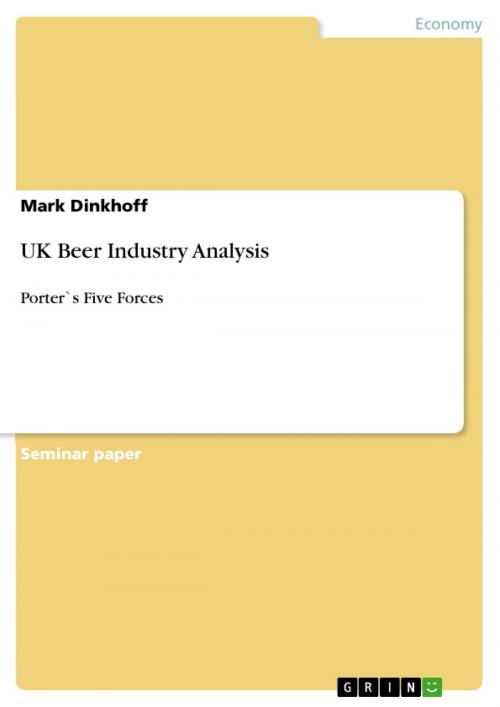| Author: | Mark Dinkhoff | ISBN: | 9783638043908 |
| Publisher: | GRIN Publishing | Publication: | May 8, 2008 |
| Imprint: | GRIN Publishing | Language: | English |
| Author: | Mark Dinkhoff |
| ISBN: | 9783638043908 |
| Publisher: | GRIN Publishing |
| Publication: | May 8, 2008 |
| Imprint: | GRIN Publishing |
| Language: | English |
Seminar paper from the year 2007 in the subject Business economics - General, grade: 1,3, University of Lincoln (School of Business and Law), course: Strategic Management, 32 entries in the bibliography, language: English, abstract: Compared with the rest of the world the UK beer consumption was on rank 5 in 2001 what shows its significance. Within the overall market value of 15,473.8 million pounds (2004), premium lager was the leading segment with a value share of 39.2 %. All in all 5,454.7 million litres of beer have been sold in 2004. Below you will find a Porter`s five forces analysis of the UK beer industry which deduces the attractiveness of the industry from its structure. The structure itself influences the corporate strategy which is responsible for corporate success finally. Attractiveness in Porter`s view depends on five forces which influence an industry. Porter says that 'the collective strength of these forces determines the ultimate profit potential of an industry.' (Porter 1980, p. 21) In order to detect the importance of a single force Porter provides some indicators which will be highlighted. I have chosen this external analysis tool because it covers a wide range of important influences affecting the UK beer industry. To anticipate the later shown results it will become ob-vious that some of the forces provided by Porter have a massive effect on the industry especially intensity of rivalry and bargaining power of buyers. Companies acting in the industry have to have good knowledge of the industry structure and its threats to defend or favourably influence it to stay competitive and earn profits. The stronger the forces are the more the industry becomes unattractive.
Seminar paper from the year 2007 in the subject Business economics - General, grade: 1,3, University of Lincoln (School of Business and Law), course: Strategic Management, 32 entries in the bibliography, language: English, abstract: Compared with the rest of the world the UK beer consumption was on rank 5 in 2001 what shows its significance. Within the overall market value of 15,473.8 million pounds (2004), premium lager was the leading segment with a value share of 39.2 %. All in all 5,454.7 million litres of beer have been sold in 2004. Below you will find a Porter`s five forces analysis of the UK beer industry which deduces the attractiveness of the industry from its structure. The structure itself influences the corporate strategy which is responsible for corporate success finally. Attractiveness in Porter`s view depends on five forces which influence an industry. Porter says that 'the collective strength of these forces determines the ultimate profit potential of an industry.' (Porter 1980, p. 21) In order to detect the importance of a single force Porter provides some indicators which will be highlighted. I have chosen this external analysis tool because it covers a wide range of important influences affecting the UK beer industry. To anticipate the later shown results it will become ob-vious that some of the forces provided by Porter have a massive effect on the industry especially intensity of rivalry and bargaining power of buyers. Companies acting in the industry have to have good knowledge of the industry structure and its threats to defend or favourably influence it to stay competitive and earn profits. The stronger the forces are the more the industry becomes unattractive.















